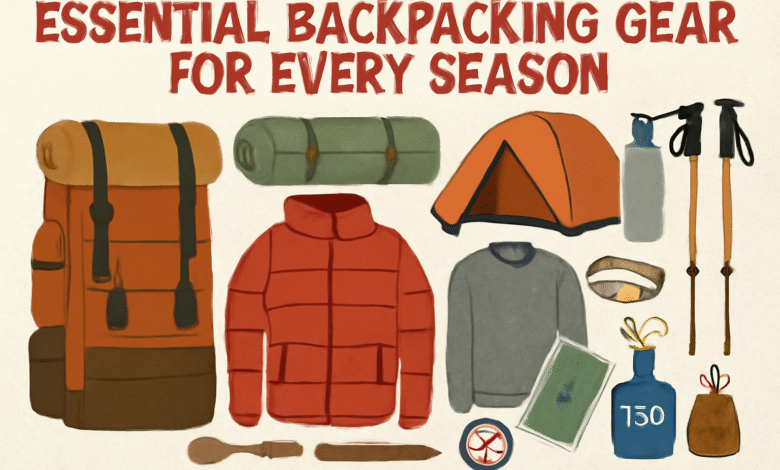Essential Backpacking Gear for Every Season

Backpacking is an adventure that appeals to many outdoor enthusiasts, offering the freedom to explore nature, disconnect from everyday life, and embrace the great outdoors. However, a successful backpacking trip requires more than just a sense of adventure. It demands proper planning, preparation, and, most importantly, the right gear. Whether you’re embarking on a weekend hike or an extended wilderness expedition, ensuring you have the right equipment for every season can make all the difference between a comfortable experience and a challenging one. In this article, we’ll break down the essential backpacking gear you need for each season to help you stay safe, warm, and prepared no matter the weather.
Spring: Embracing New Beginnings
Spring is an exciting time for backpacking, as nature starts to come alive with blooming flowers, fresh green leaves, and the scent of damp earth. However, this season can also present a range of challenges, such as unpredictable weather, fluctuating temperatures, and muddy trails. The key to a successful spring backpacking trip is being prepared for a variety of conditions.
1. Waterproof Gear for Spring Showers
Spring weather can be fickle, with frequent rain showers and sudden drops in temperature. As such, having waterproof gear is essential. A good rain jacket and pants can protect you from the rain and wind, while waterproof boots will keep your feet dry and comfortable on muddy trails. Additionally, consider packing a lightweight, breathable rain cover for your backpack to protect your gear from getting soaked.
2. Light Layers for Temperature Changes
Spring temperatures can swing dramatically throughout the day, so layering is key. A moisture-wicking base layer, such as a long-sleeve shirt, will help regulate your body temperature and keep you dry. An insulating mid-layer, like a fleece or lightweight down jacket, provides warmth when needed. Finally, a durable outer layer like a windbreaker or softshell jacket can protect you from wind and light rain.
3. Backpacking Essentials for Spring
When it comes to spring backpacking, the backpacking essentials remain relatively consistent with other seasons, but the key difference is the emphasis on lightweight, breathable gear. You’ll want to bring a comfortable, multi-season sleeping bag that provides enough warmth but doesn’t overheat. A small, compact sleeping pad is ideal for those spring trips, offering insulation from the cold ground while maintaining portability. A reliable stove or cooking system is essential for those chilly mornings and evenings when a hot meal or drink will keep your spirits high. Additionally, a good-quality hydration system is crucial as spring temperatures can fluctuate, making proper hydration important for your stamina.
4. Insect Protection
Spring also means the return of insects, such as mosquitoes, ticks, and other pests. A lightweight bug net can help protect you from these insects during your sleep or while you take a break. You should also pack insect repellent to apply to exposed skin and clothing to reduce the risk of bites and potential disease transmission.
Summer: Thriving in the Heat
Summer backpacking can be the most enjoyable time to hit the trails, with long days, clear skies, and warm temperatures. However, this season also presents its own set of challenges, such as intense heat, dehydration, and sun exposure. To make the most of your summer adventure, you’ll need gear designed to keep you cool, hydrated, and protected from the sun.
1. Sun Protection
The intense summer sun can lead to sunburn and dehydration if you’re not careful. Make sure to pack a high-SPF sunscreen and apply it regularly, especially on exposed skin. A wide-brimmed hat and UV-protective sunglasses will also help shield your face and eyes from harmful UV rays. Lightweight, breathable clothing, such as long-sleeve shirts and pants, can protect your skin from the sun while keeping you cool.
2. Hydration System
Staying hydrated is crucial during summer backpacking trips, as you can lose significant fluids through sweat. A hydration bladder or water bottles are essential for keeping water easily accessible during the day. Be sure to carry enough water and have a method of purifying water, like a portable filter or purification tablets, in case you need to refill along the trail.
3. Ultralight Gear
During summer, you’ll want to lighten your load as much as possible to avoid carrying excess weight in the heat. Ultralight tents, sleeping bags, and stoves can make a huge difference in your comfort and energy levels. Consider a compact, lightweight tent that offers good ventilation to keep you cool at night. A summer-specific sleeping bag, which is lighter and more breathable, will also help regulate your body temperature while ensuring a restful sleep.
4. Lightweight Cooking System
Since you’ll likely be hiking in warmer temperatures, you may not need as many hot meals. A compact cooking system, such as a lightweight stove or campfire cooking kit, will allow you to prepare simple, easy-to-make meals without adding unnecessary weight. Consider bringing energy-dense snacks, like trail mix or energy bars, to keep your energy up without needing to prepare complex meals.
Fall: Preparing for the Chill
Fall is one of the best times to go backpacking. The crisp air, colorful foliage, and cooler temperatures create the perfect backdrop for an outdoor adventure. However, the drop in temperature can also lead to cold nights and unpredictable weather, so you need to adjust your gear accordingly.
1. Layering for Warmth
As the temperatures begin to drop in fall, layering becomes essential. A thermal base layer will keep you warm by trapping body heat, while a heavier mid-layer, like a down jacket or wool sweater, will provide additional warmth. For your outer layer, choose a weather-resistant jacket to shield you from wind, rain, or snow. As always, make sure your layers are moisture-wicking to prevent sweating and dampness, which can lead to discomfort and hypothermia.
2. Cold-Weather Sleeping Gear
As the nights grow colder in the fall, a three-season sleeping bag becomes a necessity. These bags are designed to keep you warm in temperatures ranging from 20°F to 32°F (-6°C to 0°C), making them ideal for autumn backpacking trips. A sleeping pad with good insulation is also crucial to keep you off the cold ground and maintain warmth throughout the night.
3. Pack a Stove for Hot Meals
The cooler fall air can make a hot meal especially satisfying. A portable stove and cooking system will allow you to heat up soups, stews, or coffee to warm you up after a long day on the trail. Make sure to pack lightweight cookware that won’t add unnecessary bulk to your pack. Opt for freeze-dried meals that are easy to prepare and lightweight but still provide the nutrients you need to stay energized.
4. Headlamp for Shorter Days
In the fall, daylight hours shorten, which means you might find yourself hiking in the dark or setting up camp before the sun goes down. A reliable headlamp or flashlight with extra batteries is an essential tool to have. Choose a headlamp with adjustable brightness settings to conserve battery life when possible.
Winter: Battling the Cold
Winter backpacking can be one of the most rewarding experiences for those who are well-prepared. The serene, snowy landscapes and crisp air provide a sense of solitude and beauty that’s hard to find in other seasons. However, winter hiking presents unique challenges, such as freezing temperatures, snow, and shorter daylight hours. Proper preparation is key to staying safe and comfortable in these harsh conditions.
1. Insulated Clothing
Winter backpacking requires clothing designed to retain warmth while wicking moisture away from your body. Layering is critical, with a thick, insulated base layer that traps heat close to your body, a warm mid-layer, and a waterproof, windproof outer layer that shields you from the elements. Don’t forget about your extremities—insulated gloves, socks, and a hat are essential for keeping your hands, feet, and head warm.
2. Winter-Specific Sleeping Bag
A winter-specific sleeping bag is a must when heading out into the cold. These bags are rated for much colder temperatures, with additional insulation and design features to keep you warm. You may also need to use a four-season tent that can withstand snow and harsh winds. Make sure to pack extra blankets or liners for additional warmth.
3. Snow Gear
If you’re planning on trekking through snowy or icy terrain, crampons, microspikes, and gaiters will help you maintain traction and keep your feet dry. An ice axe may also be necessary if you’re traversing steep, icy slopes. A pair of insulated boots with good grip will help you navigate winter trails safely.
4. Avalanche Safety Gear
If you’re heading into backcountry areas with the potential for avalanches, make sure to carry proper avalanche safety equipment, including a beacon, probe, and shovel. Having the right gear can be lifesaving in the event of an avalanche, so take the time to familiarize yourself with how to use each piece of equipment.
Conclusion
No matter the season, proper planning and gear are essential for a successful backpacking trip. By ensuring you have the right equipment for each season, you can stay comfortable, safe, and prepared for anything the wilderness throws at you. Remember that having the right gear can be the difference between a memorable adventure and a challenging experience.
For further details on how to choose the best gear for your next backpacking adventure, visit https://www.outdoortechlab.com/backpacking-big-3/


